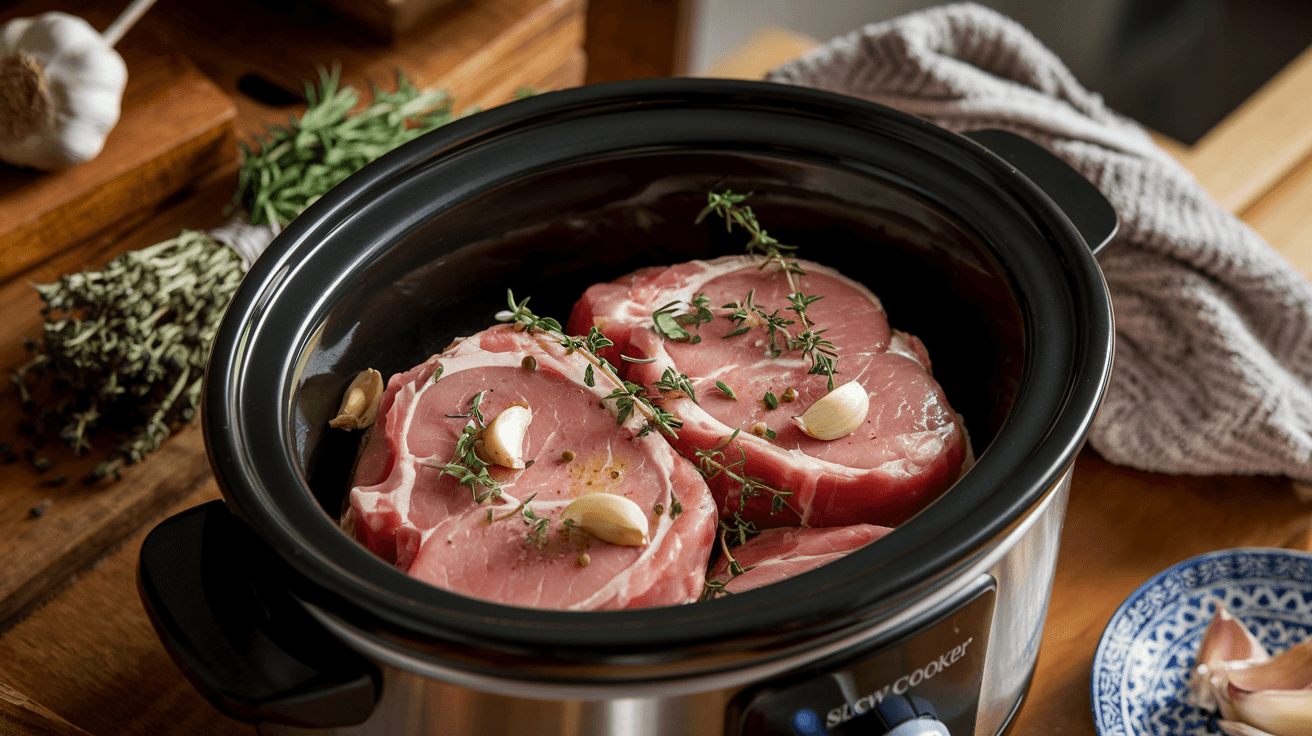Cooking pork in a slow cooker is a popular method for achieving tender, flavorful results with minimal effort. However, many home cooks wonder, “Can I put raw pork in a slow cooker?” The answer is yes! Slow cookers are designed to handle raw meat safely and effectively, turning it into a perfectly cooked dish over time.
In this guide, we’ll explore the safety, benefits, and best practices of cooking raw pork in a slow cooker. Whether you’re preparing a hearty stew, savory pulled pork, or a comforting casserole, understanding how slow cookers work will ensure your dish is both safe and delicious.
Is It Safe to Put Raw Pork in a Slow Cooker?
Yes, it is absolutely safe to put raw pork in a slow cooker, as long as proper food safety guidelines are followed. Slow cookers are designed to cook food at a consistent, low temperature over a long period, ensuring that raw pork is thoroughly cooked and safe to eat.
How Slow Cookers Ensure Safety
- Controlled Heat: Slow cookers maintain steady temperatures between 170°F (low setting) and 280°F (high setting). These temperatures are sufficient to cook raw pork thoroughly while killing harmful bacteria like Salmonella and E. coli.
- Steam Seals In Heat: The sealed lid traps steam inside, helping to maintain a moist and hot environment that speeds up cooking and ensures even heating.
Risks of Using Raw Pork Improperly
While it is safe to cook raw pork in a slow cooker, mishandling can lead to food safety issues:
- Improper Thawing: Never place frozen pork directly into the slow cooker. It can take too long to reach safe cooking temperatures, allowing bacteria to grow.
- Uneven Cooking: Large cuts of pork may cook unevenly if the slow cooker is overcrowded or if the pork is not placed in a single layer.
By understanding how slow cookers work and adhering to safe cooking practices, you can confidently prepare raw pork dishes without worry.
How Slow Cookers Work to Cook Raw Pork Safely
Slow cookers are specifically designed to cook raw meat safely and efficiently by maintaining consistent temperatures and retaining moisture. Here’s a closer look at how slow cookers ensure that raw pork is cooked thoroughly and safely.
Low and High Heat Settings
- Low Heat: Slow cookers maintain a steady temperature of approximately 170°F to 200°F on the low setting, allowing the pork to cook gradually. This is ideal for tenderizing tough cuts like pork shoulder or ribs.
- High Heat: The high setting, which ranges from 280°F to 300°F, cooks pork faster while still ensuring thorough cooking. This is a good option for leaner cuts or when you’re short on time.
Retaining Moisture and Flavor
The sealed design of a slow cooker ensures that:
- Moisture Stays Trapped: The lid locks in steam, which prevents the pork from drying out.
- Flavor Develops Over Time: The slow cooking process allows flavors from seasonings, sauces, and added ingredients to infuse deeply into the pork.
Heat Distribution
Slow cookers distribute heat evenly around the pork, ensuring all parts of the meat reach a safe internal temperature. To confirm doneness, use a meat thermometer to check that the pork reaches at least 145°F, as recommended by the USDA.
By leveraging these features, you can cook raw pork safely while achieving tender, juicy results every time.
Benefits of Cooking Raw Pork in a Slow Cooker
Using a slow cooker to prepare raw pork comes with several advantages, making it a favorite method for home cooks. Here’s why slow cooking is an excellent choice:
1. Convenience
Slow cookers allow you to prepare meals with minimal effort:
- Simply add the raw pork and other ingredients, set the timer, and let the slow cooker do the work.
- Perfect for busy schedules, as it requires little monitoring during the cooking process.
2. Tender and Juicy Results
The low and slow cooking process breaks down tough fibers in the pork, resulting in melt-in-your-mouth tenderness:
- Ideal for cuts like pork shoulder, ribs, or pork butt.
- Retains the meat’s natural juices, preventing dryness.
3. Enhanced Flavor
Cooking raw pork in a slow cooker allows flavors to develop and deepen over time:
- Spices, sauces, and seasonings infuse into the meat during the long cooking process.
- The result is rich, flavorful pork that’s perfect for dishes like pulled pork, stews, or casseroles.
4. Energy Efficiency
Slow cookers use less electricity compared to ovens or stovetops, making them a cost-effective option for preparing meals.
5. Versatility
From savory stews to barbecue pulled pork, a slow cooker can handle a wide variety of pork recipes. You can experiment with different cuts, sauces, and seasonings to suit your taste preferences.
By offering convenience, flavor, and versatility, slow cookers make preparing raw pork simple and rewarding.
Best Practices for Cooking Raw Pork in a Slow Cooker
To ensure your pork is both safe and delicious, follow these best practices when preparing it in a slow cooker.
1. Choosing the Right Cut
Different cuts of pork yield different results in a slow cooker. Select the cut that best suits your recipe:
- Pork Shoulder or Butt: Ideal for pulled pork due to its marbled fat content.
- Pork Loin or Tenderloin: Best for lean, tender dishes.
- Ribs: Slow cooking makes ribs fall-off-the-bone tender.
2. Preparing the Pork
- Trim Excess Fat: While some fat enhances flavor, too much can make the dish greasy. Trim excess fat before placing the pork in the slow cooker.
- Season Generously: Apply a dry rub or marinade to the raw pork for better flavor absorption during the slow cooking process.
3. Using the Right Liquid Ratios
Adding liquid is essential to keep the pork moist and prevent burning:
- Minimum Liquid: Use at least 1/2 cup of liquid (broth, water, or sauce) to create a steamy environment for cooking.
- Flavorful Base: Use chicken or vegetable broth, apple juice, or a combination of sauces for added flavor.
4. Layering Ingredients
For even cooking and flavor distribution:
- Place vegetables like onions, carrots, or potatoes at the bottom of the slow cooker.
- Lay the pork on top of the vegetables to allow heat to circulate evenly.
5. Timing and Temperature Tips
- Low Heat: Cook for 6–8 hours for tender, juicy results.
- High Heat: Use for 3–4 hours if you’re short on time, but check frequently to avoid overcooking.
- Internal Temperature: Use a meat thermometer to ensure the pork reaches a safe temperature of 145°F (63°C).
6. Avoid Overcrowding
- Ensure the slow cooker is not overfilled to allow proper heat circulation. A maximum of 3/4 full is ideal.
7. Stirring and Adjusting
- Avoid lifting the lid frequently during cooking, as this releases heat and increases cooking time.
- Stir the contents gently only if necessary, especially when cooking with sauces.
By following these best practices, you’ll achieve perfectly cooked, flavorful pork every time.
Common Mistakes to Avoid
Cooking raw pork in a slow cooker is straightforward, but avoiding these common mistakes will ensure your dish turns out perfectly every time.
1. Using Frozen Pork
- Why It’s a Problem: Frozen pork takes longer to thaw in a slow cooker, keeping it in the temperature “danger zone” (40°F to 140°F) where bacteria can grow.
- Solution: Always thaw pork completely in the refrigerator before adding it to the slow cooker.
2. Overcrowding the Slow Cooker
- Why It’s a Problem: Overcrowding prevents even cooking and can leave parts of the pork undercooked.
- Solution: Fill the slow cooker no more than 3/4 full, and arrange ingredients in layers for optimal heat distribution.
3. Not Adding Enough Liquid
- Why It’s a Problem: Without enough liquid, the pork can dry out or burn during cooking.
- Solution: Add at least 1/2 cup of liquid, such as broth, water, or sauce, to keep the pork moist and flavorful.
4. Lifting the Lid Too Often
- Why It’s a Problem: Each time you lift the lid, heat escapes, which increases cooking time and disrupts the slow cooking process.
- Solution: Resist the urge to check too often. Trust the slow cooker and only lift the lid when absolutely necessary.
5. Overcooking Lean Cuts
- Why It’s a Problem: Lean cuts like pork loin or tenderloin can become dry and tough if cooked too long.
- Solution: Use a meat thermometer to check doneness and follow recommended cooking times for lean cuts (3–4 hours on high or 6–8 hours on low).
6. Skipping the Seasoning
- Why It’s a Problem: Pork can taste bland without proper seasoning or marinades.
- Solution: Season generously or use marinades to enhance flavor. Add herbs, spices, or rubs to infuse the pork with bold tastes.
By steering clear of these common mistakes, you’ll be able to enjoy perfectly cooked, flavorful pork every time you use your slow cooker.
Frequently Asked Questions (FAQs)
1. Can I Put Frozen Pork in a Slow Cooker?
It’s not recommended to cook frozen pork in a slow cooker because it may stay in the temperature danger zone (40°F–140°F) for too long, allowing bacteria to grow.
- Solution: Always thaw pork in the refrigerator before adding it to the slow cooker.
2. How Long Does It Take to Cook Raw Pork in a Slow Cooker?
The cooking time depends on the cut and thickness of the pork:
- Low Heat: 6–8 hours for most cuts.
- High Heat: 3–4 hours.
Always check for an internal temperature of at least 145°F for safe consumption.
3. Do I Need to Sear the Pork Before Slow Cooking?
Searing is optional but recommended for added flavor:
- Benefits: Searing creates a caramelized crust that enhances the dish’s taste.
- Tip: Quickly brown the pork in a hot skillet with oil before placing it in the slow cooker.
4. What’s the Best Liquid to Use in a Slow Cooker?
The liquid you use depends on your flavor preference:
- Chicken or Vegetable Broth: Adds depth and keeps the pork moist.
- Apple Juice or Cider: Complements pork with a touch of sweetness.
- Barbecue Sauce: Ideal for pulled pork recipes.
5. Can I Cook Pork Without Liquid in a Slow Cooker?
While some fat-rich cuts may release enough natural juices during cooking, adding at least 1/2 cup of liquid ensures the pork stays moist and prevents burning.
6. How Can I Tell When the Pork Is Done?
Use a meat thermometer to check doneness:
- Safe Temperature: Pork is ready when it reaches an internal temperature of 145°F and rests for 3 minutes before serving.
For more tips and slow cooker pork recipes, explore our Slow Cooker Pork Chops Recipe.
Conclusion
Cooking raw pork in a slow cooker is not only safe but also an excellent way to prepare tender, flavorful meals with minimal effort. By understanding how slow cookers work and following best practices, you can ensure that your pork is cooked thoroughly and infused with delicious flavors.
From choosing the right cut of pork to layering ingredients and adding the right amount of liquid, each step contributes to a successful dish. Avoid common mistakes like overcrowding or lifting the lid too often, and you’ll enjoy perfectly cooked pork every time.
Whether you’re preparing a family dinner or experimenting with new recipes, the versatility of slow cooking makes it an indispensable tool for any kitchen. For more ideas and inspiration, check out our Slow Cooker Pork Chops Recipe. or explore other comforting dishes in our Dinner Recipes.

